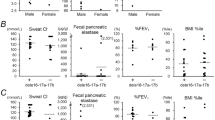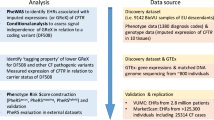Abstract
Cystic fibrosis (CF) is caused by mutations in the CF transmembrane conductance regulator (CFTR) gene but the association between mutation (genotype) and disease presentation (phenotype) is not straightforward. We have been investigating whether variants in the CFTR gene that alter splicing efficiency of exon 9 can affect the phenotype produced by a mutation. A missense mutation, R117H, which has been observed in three phenotypes, was found to occur on two chromosome backgrounds with intron 8 variants that have profoundly different effects upon splicing efficiency. A close association is shown between chromosome background of the R117H mutation and phenotype. These findings demonstrate that the genetic context in which a mutation occurs can play a significant role in determining the type of illness produced.
This is a preview of subscription content, access via your institution
Access options
Subscribe to this journal
Receive 12 print issues and online access
$209.00 per year
only $17.42 per issue
Buy this article
- Purchase on Springer Link
- Instant access to full article PDF
Prices may be subject to local taxes which are calculated during checkout
Similar content being viewed by others
References
Boat, T.F., Welsh, M.J. & Beaudet, A.L. Cystic Fibrosis. In The Metabolic Basis of Inherited Disease (eds Scriver, C.L. et al.) 2649–2680 (New York, McGraw-Hill, 1989).
Kerem, E. et al. The relation between genotype and phenotype in cystic fibrosis-analysis of the most common mutation (ΔF508). New Eng. J. Med. 323, 1517–1522 (1990).
Hamosh, A. et al. Cystic fibrosis patients bearing the common missense mutation Gly→Asp at codon 551 and the ΔF508 are indistinguishable from ΔF508 homozygotes except for decreased risk of meconium ileus. Am. J. hum. Genet. 51, 245–250 (1992).
Kristidis, P. et al. Genetic determination of exocrine pancreatic function in cystic fibrosis. Am. J. hum. Genet. 50, 1178–1184 (1992).
Hamosh, A. Preliminary results of the cystic fibrosis genotype-phenotype consortium study. Ped. Pulm. 8, 144–145 (1992).
Osborne, L. et al. Incidence and expression of the N1303K mutation of the cystic fibrosis (CFTR) gene. Hum. Genet. 89, 653–658 (1992).
Hamosh, A. & Cutting, G.R. Genotype/phenotype relationships in cystic fibrosis. In Current topics in cystic fibrosis, (eds Dodge, J.A. et al.) 69–89 (Chichester, Wiley, 1993).
Dork, T. et al. Cystic fibrosis with three mutations in the cystic fibrosis transmembrane conductance regulator gene. Hum. Genet. 87, 441–446 (1991).
Kalin, N., Dork, T. & Tummler, B. A cystic fibrosis allele encoding missense mutations in both nucieotide binding folds of the cystic fibrosis transmembrane conductance regulator. Hum. Mut. 1, 204–210 (1993).
Chu, C.-S. et al. Variable deletion of exon 9 coding sequences in cystic fibrosis transmembrane conductance regulator gene mRNA transcripts in normal bronchial epithelium. EMBO J. 10, 1355–1363 (1991).
Chu, C.-S. et al. Genetic basis of variable exon 9 skipping in cystic fibrosis transmembrane conductance regulator mRNA. Nature Genet. 3, 151–156 (1993).
Strong, T.V. et al. Expression of an abundantly alternatively spliced form of the cystic fibrosis transmembrane conductance regulator (CFTR) gene is not associated with a cAMP-activated chloride conductance. Hum. molec. Genet. 2, 225–230 (1993).
Dean, M. et al. Multiple mutations in highly conserved residues are found in mildly affected cystic fibrosis patients. Cell 61, 863–870 (1990).
Amos, J.A. et al. Congenital absence of the vas deferens: A primarily genital form of cystic fibrosis. Ped. Pulm. 8, 142–143 (1992).
Lee, R. et al. Identification of previously undiagnosed cystic fibrosis patients: an unexpected outcome of prenatal carrier screening. Am. J. hum. Genet. 51, A32 Abstr. (1992).
Witt, D.R. et al. Cystic fibrosis carrier screening in a prenatal population. Am. J. hum. Genet. 51, A16 abstr. (1992).
Zielenski, J. et al. Identification of mutations in exons 1 through 8 of the cystic fibrosis transmembrane conductance regulator (CFTR) gene. Genomics 10, 229–235 (1991).
Dork, T. et al. Intra and extragenic marker haplotypes of CFTR mutations in cytic fibrosis families. Hum. Genet. 88, 417–425 (1992).
Youssoufian, H. et al. Recurrent mutations in haemophilia A give evidence for CpG mutation hotspots. Nature 324, 380–382 (1986).
Reiss, J. et al. Discrimination between recurrent mutation and identity by descent: application to point mutations in exon 11 of the CFTR gene. Hum. Genet. 87, 457–461 (1991).
Tsui, L.-C. The spectrum of cystic fibrosis mutations. TIG 8, 392–398 (1992).
Carroll, T.P. et al. Transmembrane mutations alter the channels characterisitics of the cystic fibrosis transmembrane conductance regulator expressed in Xenopus oocytes. Cell. Physiol. Biochem. (in the press).
Sheppard, D.N. et al. Mutations in CFTR associated with mild-disease-form Cl− channels with altered pore properties. Nature 362, 160–164 (1993).
Latham, T., Grabowski, G.A., Theophilus, B.D. & Smith, F.I. Complex alleles of the acid beta-glucosidase gene in Gaucher disease Complex alleles of the acid beta-glucosidase gene in Gaucher disease. Am. J. hum.Genet. 47, 79–86 (1990).
Handelin, B.L., Witt, D., Skoletsky, J. & Shuber, A. Unexpected prevalence of R117H and G551D CF mutations in a randomly screened population. Am. J. hum. Genet. 51, A218 Abstr. (1992).
Zielenski, J. et al. Genomic DNA sequence of the cystic fibrosis transmembrane conductance regulator (CFTR) gene. Genomics 10, 214–228 (1991).
Zeitlin, P.L. et al. A cystic fibrosis bronchial epithelial cell line: Immortalization by Adeno-12-SV40 infection. Am. J. Resp. Cell. molec. Biol. 4, 313–319 (1991).
Horn, G.T., Richards, B., Merrill, J.J. & Klinger, K.W. Characterization and rapid diagnostic analysis of DNA polymorphisms closely linked to the cystic fibrosis locus. Clin. Chem. 36, 1614–1619 (1990).
Estivill, X. et al. Isolation of a new DNA marker in linkage disequilibrium with cystic fibrosis, situated between J3.11 (D7S8) and IRP. Am. J. hum. Genet. 44, 704–710 (1989).
Kerem, B. et al. Identification of the cystic fibrosis gene: genetic analysis. Science 245, 1073–1080 (1989).
Chehab, F.F. et al. A dimorphic 4-bp repeat in the cystic fibrosis gene is in absolute linkage disequilibrium with the ΔF508 mutation: implications for prenatal diagnosis and mutation origin. Am. J. hum. Genet. 48, 223–226 (1991).
Kerem, B. et al. Identification of mutations in regions corresponding to the 2 putative nucleotide (ATP)-binding folds of the cystic fibrosis gene. Proc. natn. Acad. Sci. U.S.A. 87, 8447–8451 (1990).
Cutting, G.R. et al. A cluster of Cystic Fibrosis mutations in the first nucieotide binding domain of the CFTR protein. Nature 346, 366–369 (1990).
Audrezet, M.P. et al. Identification of 12 novel mutations in the CFTR gene. Hum. molec. Genet. 2, 51–54 (1993).
Author information
Authors and Affiliations
Rights and permissions
About this article
Cite this article
Kiesewetter, S., Macek, M., Davis, C. et al. A mutation in CFTR produces different phenotypes depending on chromosomal background. Nat Genet 5, 274–278 (1993). https://doi.org/10.1038/ng1193-274
Received:
Accepted:
Issue Date:
DOI: https://doi.org/10.1038/ng1193-274
This article is cited by
-
Preclinical dose response study shows NR2E3 can attenuate retinal degeneration in the retinitis pigmentosa mouse model RhoP23H+/−
Gene Therapy (2024)
-
Novel mutation c.1210-3C > G in cis with a poly-T tract of 5T affects CFTR mRNA splicing in a Chinese patient with cystic fibrosis
Frontiers of Medicine (2022)
-
Nr2e3 is a genetic modifier that rescues retinal degeneration and promotes homeostasis in multiple models of retinitis pigmentosa
Gene Therapy (2021)
-
Use of ivacaftor in late diagnosed cystic fibrosis monozygotic twins heterozygous for F508del and R117H-7T – a case report
BMC Pulmonary Medicine (2019)
-
The effect of CFTR modulators on a cystic fibrosis patient presenting with recurrent pancreatitis in the absence of respiratory symptoms: a case report
BMC Gastroenterology (2019)



